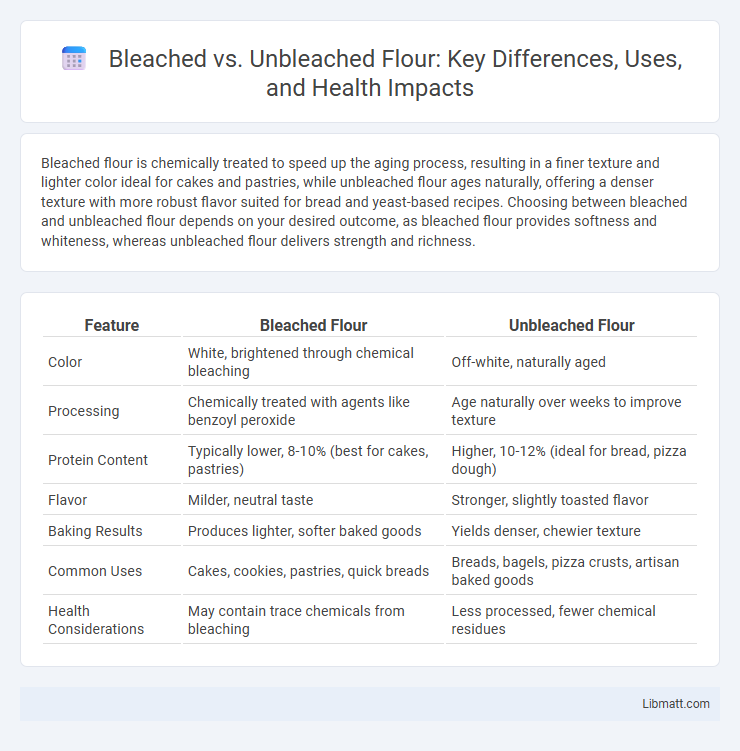Bleached flour is chemically treated to speed up the aging process, resulting in a finer texture and lighter color ideal for cakes and pastries, while unbleached flour ages naturally, offering a denser texture with more robust flavor suited for bread and yeast-based recipes. Choosing between bleached and unbleached flour depends on your desired outcome, as bleached flour provides softness and whiteness, whereas unbleached flour delivers strength and richness.
Table of Comparison
| Feature | Bleached Flour | Unbleached Flour |
|---|---|---|
| Color | White, brightened through chemical bleaching | Off-white, naturally aged |
| Processing | Chemically treated with agents like benzoyl peroxide | Age naturally over weeks to improve texture |
| Protein Content | Typically lower, 8-10% (best for cakes, pastries) | Higher, 10-12% (ideal for bread, pizza dough) |
| Flavor | Milder, neutral taste | Stronger, slightly toasted flavor |
| Baking Results | Produces lighter, softer baked goods | Yields denser, chewier texture |
| Common Uses | Cakes, cookies, pastries, quick breads | Breads, bagels, pizza crusts, artisan baked goods |
| Health Considerations | May contain trace chemicals from bleaching | Less processed, fewer chemical residues |
Introduction to Bleached and Unbleached Flour
Bleached flour undergoes a chemical whitening process using agents like chlorine dioxide or benzoyl peroxide, resulting in a finer texture and faster oxidation, ideal for tender baked goods such as cakes and cookies. Unbleached flour is naturally aged without chemical additives, retaining a denser texture and slightly off-white color that works well for bread, pastries, and recipes requiring stronger gluten development. Your choice between bleached and unbleached flour affects not only the color and texture of baked goods but also their flavor and nutritional profile.
What is Bleached Flour?
Bleached flour is refined wheat flour treated with chemical agents such as benzoyl peroxide or chlorine gas to accelerate the aging process and produce a finer, whiter texture. This treatment alters the flour's protein structure, resulting in softer, more tender baked goods like cakes and pastries. Your choice between bleached and unbleached flour can impact the texture and color of your baked recipes depending on the desired outcome.
What is Unbleached Flour?
Unbleached flour is made from wheat flour that undergoes a natural aging process without chemical bleaching agents, resulting in a denser texture and off-white color. It retains more of the wheat's natural nutrients, such as protein and vitamins, compared to bleached flour. Bakers often prefer unbleached flour for its superior strength and richer flavor, making it ideal for artisan breads and pastries.
Key Differences Between Bleached and Unbleached Flour
Bleached flour undergoes chemical treatment with agents like benzoyl peroxide to speed up the aging process, resulting in a softer texture and whiter color, while unbleached flour is naturally aged, retaining a denser texture and off-white hue. The proteins in unbleached flour create stronger gluten, making it ideal for bread making, whereas bleached flour's lower protein content suits cakes and pastries that require a tender crumb. Your choice between the two flours affects the final texture and appearance of baked goods, making it essential to consider the specific baking application.
Nutritional Comparison
Bleached flour undergoes chemical processing with agents like chlorine dioxide that can reduce certain nutrients, such as vitamin E and carotenoids, whereas unbleached flour retains more natural vitamins and minerals. Both types have similar macronutrient profiles, including carbohydrates and protein, but unbleached flour may have slightly higher antioxidant levels due to minimal processing. Choosing unbleached flour can provide a marginal nutritional advantage, particularly in preserving natural nutrients and phytochemicals.
Impact on Baking and Texture
Bleached flour undergoes chemical treatment that weakens gluten strands, resulting in softer, finer-textured baked goods like cakes and cookies. Unbleached flour retains a denser protein structure, producing chewier, more robust textures ideal for bread and pastries requiring strength and elasticity. Your choice between bleached and unbleached flour directly affects the rise, crumb, and mouthfeel of your baked creations.
Health Considerations
Bleached flour undergoes chemical treatment with agents like benzoyl peroxide or chlorine gas to speed up the whitening process, which can reduce some nutrients. Unbleached flour retains more of its natural nutrients and antioxidants since it isn't chemically treated, making it a healthier option for your baking needs. Choosing unbleached flour may support better digestive health and reduce exposure to synthetic chemicals in your diet.
Common Uses in Cooking and Baking
Bleached flour is often preferred for cakes, cookies, and pastries due to its softer texture and faster aging process, which enhances gluten development for tender baked goods. Unbleached flour retains more natural nutrients and has a denser, firmer texture, making it ideal for breads, pizza dough, and pie crusts where a chewy, structured crumb is desired. Both flours are versatile, but selecting bleached or unbleached varieties depends on the desired texture and rise in specific recipes.
How to Choose the Right Flour for Your Recipe
Choosing the right flour for your recipe depends on your desired texture and baking goals. Bleached flour undergoes chemical treatment for a softer texture and faster baking, ideal for cakes and cookies, while unbleached flour retains natural pigments, offering a denser structure suitable for breads and pastries. Understanding these differences helps you achieve optimal results in taste and appearance for your baked goods.
Final Thoughts: Which Flour Is Better?
Choosing between bleached flour and unbleached flour depends on your baking needs and health preferences. Bleached flour offers a finer texture and brighter color ideal for cakes and pastries, while unbleached flour provides a denser texture and richer flavor suited for breads and cookies. Your best choice aligns with the desired texture, flavor, and nutritional considerations of your recipes.
Bleached Flour vs Unbleached Flour Infographic

 libmatt.com
libmatt.com